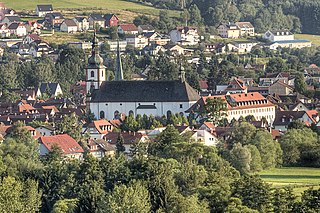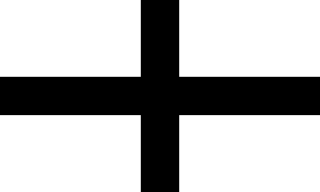
Fulda is a town in Hesse, Germany; it is located on the river Fulda and is the administrative seat of the Fulda district (Kreis). In 1990, the town hosted the 30th Hessentag state festival.
Wartburgkreis is a Kreis (district) in the west of Thuringia, Germany. Neighboring districts are the districts Unstrut-Hainich-Kreis, Gotha, Schmalkalden-Meiningen, and the districts Fulda, Hersfeld-Rotenburg and Werra-Meißner-Kreis in Hesse.

The Rhön Mountains are a group of low mountains in central Germany, located around the border area where the states of Hesse, Bavaria and Thuringia come together. These mountains, which are at the extreme southeast end of the East Hesse Highlands, are partly a result of ancient volcanic activity. They are separated from the Vogelsberg Mountains by the river Fulda and its valley. The highest mountain in the Rhön is the Wasserkuppe, which is in Hesse. The Rhön Mountains are a popular tourist destination and walking area.

A chapter house or chapterhouse is a building or room that is part of a cathedral, monastery or collegiate church in which meetings are held. When attached to a cathedral, the cathedral chapter meets there. In monasteries, the whole community often met there daily for readings and to hear the abbot or senior monks talk. When attached to a collegiate church, the dean, prebendaries and canons of the college meet there. The rooms may also be used for other meetings of various sorts; in medieval times monarchs on tour in their territory would often take them over for their meetings and audiences. Synods, ecclesiastical courts and similar meetings often took place in chapter houses.

Saint Wigbert, (Wihtberht) born in Wessex around 675, was an Anglo-Saxon Benedictine monk and a missionary and disciple of Saint Boniface who travelled with the latter in Frisia and northern and central Germany to convert the local tribes to Christianity. His feast day is August 13.
Rudi Arnstadt was an East German border guard who died in an incident with West German border guards at the Inner German border on 14 August 1962. Arnstadt, a captain of the Border Troops of the German Democratic Republic, was shot and killed by Bundesgrenzschutz officer Hans Plüschke near Wiesenfeld during a shootout that occurred under unknown circumstances. Arnstadt's death caused an escalation of Cold War tensions.

Bad Soden-Salmünster is a town in the Main-Kinzig district, in Hesse, Germany. It is situated on the river Kinzig, between Fulda and Hanau. It has a population of around 13,000.

Amöneburg is a town in the Marburg-Biedenkopf district in Hesse, Germany. It lies on a mountain and is built around the castle of the same name, Burg Amöneburg.

Hersfeld Abbey was an important Benedictine imperial abbey in the town of Bad Hersfeld in Hesse, Germany, at the confluence of the rivers Geisa, Haune and Fulda.

Geisa is a town in the Wartburgkreis district, in Thuringia, Germany. It is situated in the Rhön Mountains, 26 km northeast of Fulda. The near border with Hesse was the border between West Germany and the GDR during the Cold War. Thus, Geisa was in the East German border restriction area of the former inner German border, which meant that until reunification access to the town was limited. The town is the westernmost municipality in what was formerly East Germany.

Observation Post Alpha, OP Alpha, or Point Alpha was a Cold War observation post between Rasdorf, Hesse, in what was then West Germany and Geisa, Thuringia, then part of East Germany. The post overlooked part of the "Fulda Gap", which would have been a prime invasion route for Warsaw Pact forces had the Cold War erupted into actual warfare. It was abandoned by the military in 1991. Today, the "Point Alpha" memorial commemorates the observation point's four decades of existence. The memorial is dedicated to keeping it and a nearby section of the inner German border as reminders of the division of Germany and the confrontation between NATO and Warsaw Pact in the Cold War.

St. Michael's Church in Fulda, Hesse, is considered to be the oldest replica of the Church of the Holy Sepulchre in Germany, built in the Carolingian architectural style (Pre-Romanesque) on behalf of abbot Eigil in the years. It served as a burial chapel to Fulda monastery founded in 744, which was one of the prominent cultural centres of the early Middle Ages. St. Michael stands in the neighbourhood of Fulda cathedral, and the architect was probably the monk Racholf. The rotunda and crypt remain preserved from this time. In the 10th and 11th century, the church was extended from the rotunda, and a west tower was built. In 1618 the roof over the rotunda was rebuilt with a conical roof, and in 1715 – 1716 a chapel was added to the north side. It was restored in 1853. Wall paintings in the interior date from the 11th century.
Candidus (Bruun) of Fulda was a Benedictine scholar of the ninth-century Carolingian Renaissance, a student of Einhard, and author of the vita of his abbot at Fulda, Eigil.

Schenklengsfeld is a community in Hersfeld-Rotenburg district in eastern Hessen, Germany lying roughly 30 km northeast of Fulda and 60 km southeast of Kassel.

Nentershausen is a community in Hersfeld-Rotenburg district in northeastern Hesse, Germany.

The Diocese of Fulda is a Roman Catholic diocese in the north of the German state of Hessen. It is a suffragan diocese of the Archdiocese of Paderborn. The bishop's seat is in Fulda Cathedral.

The Abbey of Fulda, from 1221 the Princely Abbey of Fulda and from 1752 the Prince-Bishopric of Fulda, was a Benedictine abbey and ecclesiastical principality centered on Fulda, in the present-day German state of Hesse.

The Gehilfersberg is a hill in the Landkreis Fulda, Hesse, Germany. It is part of the Rhön hills and lies northwest of the village of Rasdorf.
The Mainz-Hessian War of 1427 was the final military conflict in the two-century long dispute between the Archdiocese of Mainz and Landgrave of Hesse over supremacy of the Hesse region. The decisive victories of Landgrave Ludwig I over the Mainzian military leader Gottfried von Leiningen near Fritzlar and over Archbishop Konrad von Dhaun near Fulda spelled the end of Mainz's ambitions in the Hesse region. The Peace of Frankfurt, signed on December 8, 1427, decisively ended both the war and the long-standing power struggle between Hesse and Mainz.

Fulda is an electoral constituency represented in the Bundestag. It elects one member via first-past-the-post voting. Under the current constituency numbering system, it is designated as constituency 174. It is located in eastern Hesse, comprising the Fulda district and the southeastern part of the Vogelsbergkreis district.





















